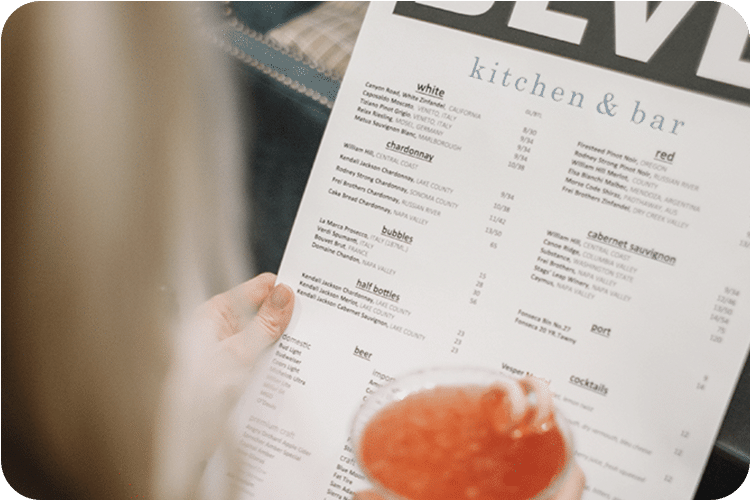By visiting our site, you agree to our privacy policy regarding cookies, tracking statistics, etc.
You’re bracing for one of your most hectic — and profitable — weekends of the year: Mother’s Day. Last year alone, it was estimated that U.S. customers would spend $5.6 billion on meals and special events.

As you gear up for the holiday, tap into the earning potential with a profitable restaurant holiday menu. From prix-fixe experiences to design hacks, keep these five strategies in mind as you start Mother’s Day restaurant menu planning.
Before you get cooking, analyze your current sales data to determine the best, most profitable dishes to feature on your holiday menu.
Say you’re planning to serve Mother’s Day brunch: Start by looking at what people typically order at your restaurant on a weekend morning. Run through the items and note how many customers request each dish. Then factor in how much it costs to make, and how much money it generates in a day. If your restaurant has offered Mother’s Day dining promotions in the past, you’ll want to break down those top sellers to decide if it’s worth reintroducing them this year.
By using a restaurant software solution linked to your POS, you can quickly pull this data with a product mix report, which shows which dishes make the most money compared to how often they’re ordered. Take it one step further and generate a report to analyze customer satisfaction for your usual weekend brunch crowd. Focus on areas like food quality, accuracy of order, and variety of food and beverages on your menu, and settle any potential snags before the holiday.
Whatever route you take, the secret to a great Mother’s Day menu is to play to your kitchen’s strengths. If your dinner service is what you’re known for, stick with it instead of venturing into brunch. The last thing you want is to overwhelm your staff and offer a subpar experience. And if nothing else, don’t underestimate the power of a small gesture like offering a complimentary slice of cake — it can go a long way in making customers feel appreciated.
Like most holidays, expectations run high on Mother’s Day. Data shows that just 1% of customers consider ordering a salad, and only 2% opt for a sandwich. Instead, they’re hungry for more indulgent options, like steak, seafood, and specialty cuisine.
That’s where menu costing comes in. The goal is to make sure you serve up dishes everyone will love, while also keeping an eye on how much each item costs to ensure you don’t spend more than you bring in.
For example, if one egg costs $0.13, and you use two eggs in your salmon and avocado eggs Benedict, the egg cost for this dish is $0.26. Repeat that step with the salmon, seasonings, cooking oil, and so on to calculate the total costs of the ingredients. Besides tracking usage, you also must record the yield from each food item to get an accurate cost on ingredients, especially on food items that are used in multiple recipes, like the avocado.
While you can complete menu costing manually, automated restaurant software is a serious time-saver here. With the right technology, you can swiftly and accurately calculate costs based on predefined ingredient prices and recipe formulations. It simplifies your menu management and enables real-time updates and adjustments, which is especially beneficial when building a one-time, holiday-specific menu.
See why more than 40,000 restaurants use Restaurant365
Here’s the fun part: Crafting a profitable restaurant menu involves more than just crunching numbers. It’s also an opportunity to tap into the psychology of consumer behavior.
Explore some savvy strategies that can help influence your customers’ choices on Mother’s Day and other restaurant holiday menus:
Pre-set menus are a popular strategy for operators that want to streamline operations while offering a memorable dining experience. A bonus is restaurants with prix-fixe menus typically see an average sales increase of 30% during special occasions like Mother’s Day compared to regular days.
The structured format of prix-fixe menus allows kitchens to prepare dishes with greater predictability and speed, reducing wait times and enhancing customer satisfaction. It’s also an opportunity to offer upscale dishes and desserts not typically available. This approach not only appeals to customers looking for an exclusive dining experience but also positions restaurants to maximize revenue during peak times.
Training your staff to cross-promote and upsell premium items on holidays like Mother’s Day can be a highly effective strategy for maximizing revenue per table. Research shows that restaurants adept at upselling can see an average increase in check size of 10% to 20%.
Plus, by integrating your restaurant management software with your POS, you can easily check reports to spot the staff who are great at upselling. Before busy times hit, teaming up less experienced salespeople with the pros gives them a chance to learn and get better, so they’re all set when things get crazy.
Whether you’re building a Mother’s Day brunch menu or dinner menu, here are some examples to try:
As you gear up for Mother’s Day, remember it’s not just about keeping up with the rush but also about maximizing your profits. By understanding your customers’ preferences, crafting a menu that highlights your kitchen’s strengths, and incorporating strategic pricing and design tactics, you can ensure a successful and lucrative holiday service.
Share this blog:
Read More:
See why more than 40,000 restaurants use Restaurant365
500 Technology Drive, Suite 200
Irvine, CA 92618
Westech 360
8911 N Capital of Texas Hwy
Building 1, Suite 1200
Austin, TX 78759
Restaurant365 bridges the gap between accounting and operations by centralizing all data, helping restaurant operators to become more efficient, accurately forecast, and tackle any challenge or opportunity with speed and accuracy.